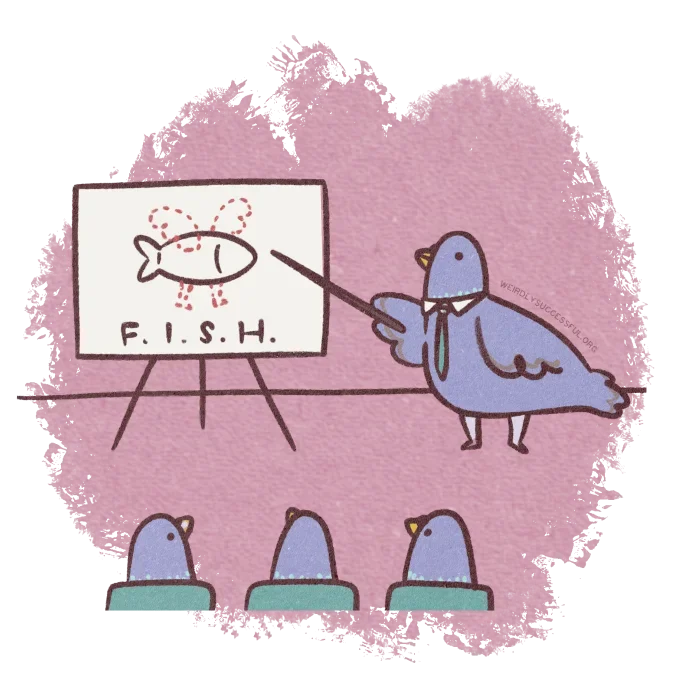‘Neurotypical’ describes people whose brain functioning follows common patterns, especially in the areas of executive functions, sensory processing, social cognition, communication patterns, and behavioural flexibility.
This means that neurotypical people generally find it easier to align with common expectations in areas like processing sensory information, understanding social cues, following conversations, and managing everyday tasks.
The word ‘typical’ in neurotypical is a statistical category more than anything else, so it simply means that certain brain wiring patterns occur more frequently in the population.
In the conversation around neurodivergence, it’s important to understand what ‘neurotypical’ means, as many of our societies are calibrated to neurotypical functioning with narrow margins of error. Understanding these elements are crucial in understanding how neurotypical-first (or neurotypical-only) environments can inadvertently disadvantage people who have neurological configurations outside the arbitrary borders of what’s considered typical.
The social aspect of neurotypicality
Looking from a social perspective, ‘neurotypical’ refers to people whose neurological development and functioning is in line not just with statistical norms, but societal expectations in the areas of cognition, perception, emotion and social participation. In this sense, neurotypicality means that the person belongs to the majority neurotype, around which social institutions, communication practices, and behavioural expectations have been designs.
The word ‘neurotypical’ was created as part of the neurodiversity movement, as a counterpart to ‘neurodivergent’. One goal of the term is to remove the stigma from neurodevelopmental differences by positing that they’re not ‘deficits’ compared with some ‘optimal’ baseline. Instead, the various types of brain functions each operate along multiple continuums.
Viewed through this framework of neurodiversity, many of the challenges of neurodivergent people actually come from having to navigate environments that were created and optimised for an arbitrary set of neurological expectations.
A neurotypical person is someone without neurodivergent conditions. A neurotypical solution is one made for neurotypical people.
What does neuronormative mean?
As much as neurotypicality itself doesn’t hold any inherent value judgment, neuronormativity is a term that points out what happens when people take the concept of neurotypicality and apply it on a social level.
A neuronormative society is one that favours and is built for neurotypical people. There’s a self-reinforcing mechanism working quietly in the background: when neurotypical existence is seen as the default, that can easily be labelled as the “good”, or “healthy” or “expected” way of being just by virtue of there being more of it. Almost immediately, though, this category creates an opposing category: the neurominority containing everyone whose brain wiring differs from the expected in any way, labelling them as “bad”, “unhealthy”, and so on.
This restrictive logic is a bit like a winner-takes-all thinking applied to the entire fabric of society, without anyone ever having consciously entered a contest — no one really has a decision in what genetics they’ll be born with.
Despite this faulty logic, this is how we end up with social systems that marginalise neurodivergent people by design. This is a form of ableism.
The opposite of a neuronormative society is a neuroaffirming one.

Is there hard science behind ‘neurotypical’?
When we’re exploring neurodivergent traits, looking at potential adaptations, or focusing on what changes might help an environment be more neuroinclusive, the social aspect of neurotypicality comes into conversation more often.
That said, it’s important to note that neurotypicality is not just a social category: there’s a neuroscientific element to it as well. From the perspective of neuroscience, neurotypical development follows predictable trajectories in:
- how new nerve cells aka. neurons develop in the brain (neurogenesis)
- how connections between neurons form in the nervous system (synaptogenesis)
- how many neural connections the brain removes that it deems infrequently used or no longer needed (neural pruning)
- how well the brain ‘insulates’ the pathways between nerve cells, by wrapping them up snugly in cute little tubes (myelination)
There’s a lot more that goes into neurodivergence from a scientific perspective (like potential issues with dopamine production, just to name one), but it’s still the case that all of these elements influence the patterns of neural connectivity and the kinds of networks that will form in the brain.
We’re yet to meet a single person who spent their childhood rigorously training their brain not to insulate their neural pathways — so it’s safe to conclude for now that the neuroscience provides another layer of proof against the outdated, stereotypical view that neurodivergent traits and conditions come down to personal behavioural choices.
Does the term neurodiversity include neurotypical people?
Yes, traditionally the term neurodiversity includes both neurotypical and neurodivergent people, though informally it is often used to only mean the neurodivergent community.
What is the difference between neurotypical and allistic?
Allistic means ‘someone who is not Autistic’. Since not every neurodivergent person is Autistic, someone can be neurodivergent and allistic. A neurotypical person is allistic by this definition.
What are professional considerations we can learn from all this?
We’re yet to meet a single person who spent their childhood rigorously training their brain not to insulate their neural pathways — so it’s safe to conclude for now that the social framework of neuronormativity and the neuroscience each provide another layer of proof against the outdated, stereotypical view that neurodivergent traits and conditions come down to personal behavioural choices.
With that in mind, professionals working with neurodivergent people in any capacity have a number of takeaways to consider:
- When working with neurodivergent individuals – children or adults -, the goal is not to support the neurodivergent person look or behave more neurotypical. All that does is affirm the harmful idea that the only way that neurodivergent people can exist is through the suppression of needs, the suppression of self-expression, the suppression of self-care and the undervaluing of mental health, all in servitude of maximising masking behaviours. Rather, it’s to acknowledge the differences, acknowledge the social imbalance, and look at each element of neurodivergence in a granular way: which are the traits that can be supported through tools, skills, or strategies; where would environmental adaptations benefit (and where are they realistic given the societal context); which traits can benefit from neurodivergence-affirming therapeutic or medical interventions.
- Be aware that the communication gap between neurotypical and neurodivergent individuals is bidirectional (also known as the double empathy problem). It’s good form to practice self-awareness around your own neurotypical assumptions and communication styles, rather than placing the entire burden of adaptation on neurodivergent people.
- Remember that while the neurotypical/neurodivergent differentiation is a useful shorthand, this doesn’t make neurodivergence a monolith. When incorporating neurodivergent perspectives into planning and implementation, talk to the people involved. Providing adaptations and support can’t be a top-down dictate – it has to be a dialogue.
- Similarly, neurotypicality isn’t a monolith either. One of the most underserved groups in this area are the people who have enough neurodivergent traits to encounter difficulties and would need support and adaptations when they come up against neurotypical societal expectations, but these traits are scattered enough across the various spectrums of neurodivergence to fly under the radar. It’s therefore important not to limit practical definitions of neurodivergence to those who have the ‘right’ combination of traits at the ‘right’ levels severity and frequency that would qualify them for an official diagnosis. Adopting a needs-based and trait-based approach can help shake off these rigid categorisations and focus instead on the human person in front of you.



